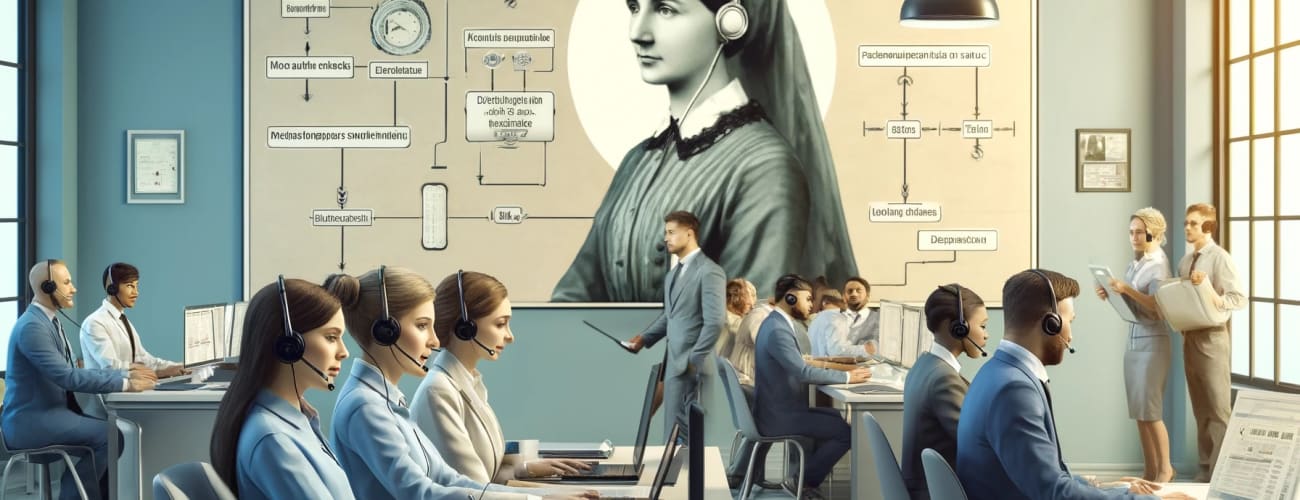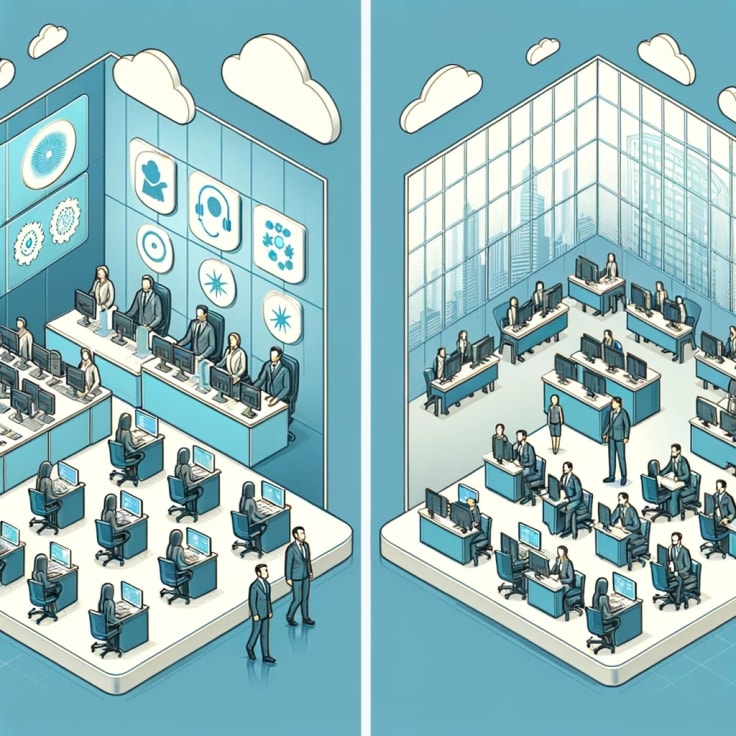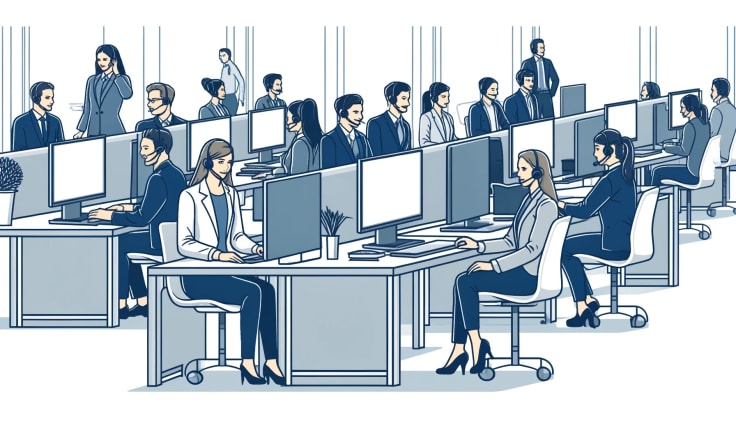Showing top 0 results 0 results found
Showing top 0 results 0 results found

Every business wants to provide great customer service, but not all customers have a great experience.
A well-structured customer service department is crucial for business success as it ensures customers receive quick and helpful responses. A clear structure helps customer service teams understand their roles and responsibilities, making it easier to deliver seamless support.
In this article, I'll explore what makes a customer service department work well, including its purpose and goals in driving business growth.
I'll also look at the key roles and responsibilities within the team, such as customer service representatives, technical support agents, and managers.
What is a customer service department?
A customer service department is the backbone of any company’s customer support operations. It comprises customer service teams responsible for handling customer concerns, managing customer interactions, and ensuring customer satisfaction.
At its core, the department serves as a bridge between the company and its customers, providing good customer service to retain loyal customers and build lasting relationships.
Purpose and goals
- Enhancing customer experience: Providing great customer service to deliver positive customer service experiences that meet customer expectations.
- Resolving customer concerns: Addressing customer issues efficiently through well-trained customer service representatives and technical support teams.
- Building brand loyalty: Ensuring loyal customers through personalized interactions, quick resolutions, and proactive support.
- Driving business growth: Increasing customer retention and attracting new customers through exceptional service.
In short, the customer service department acts as a catalyst for customer satisfaction and retention, directly influencing the company's reputation and profitability.
The role of customer service in modern businesses
The role of customer service has evolved to become a strategic pillar for business success.
Modern customer service teams aim to deliver excellent customer service while managing customer service problems to foster strong customer relationships.
Customer expectations are higher than ever, and customer service teams must consistently deliver effective support. Positive customer service experiences create loyal customers, while bad customer service can tarnish a brand's reputation and lead to customer churn. Thus, ensuring good customer service is crucial for building customer loyalty and driving business growth.
Trends influencing customer service departments
- Omnichannel support: Seamless customer interactions across multiple channels (phone, chat, email, social media) to improve customer satisfaction.
- Self-service solutions: Offering self-service options like a knowledge base and automated chatbots for instant issue resolution.
- Customer service automation: Leveraging AI to automate repetitive tasks, enhancing support team efficiency.
- Personalization: Tailoring interactions based on customer feedback and past behaviors for a more personalized customer service experience.
- Proactive support: Anticipating customer concerns and reaching out before issues arise to prevent bad customer service experiences.
- Remote support teams: Managing distributed customer support teams with digital collaboration tools.
- Data-driven insights: Using analytics to monitor customer service channels, identify trends, and optimize customer support operations.
Customer service department structure
A well-structured customer service department is like a well-oiled machine. It ensures every customer service representative knows their role, every customer support team works efficiently, and customer interactions are seamlessly handled.
Let's break down how to create an effective structure that enables customer service managers and their teams to deliver top-notch support.
Centralized vs. decentralized structures

The structure of your customer service department sets the stage for how your customer support teams will operate.
There are two main approaches – centralized and decentralized structures. Let’s take a look at them.
Centralized structure
In a centralized structure, the customer service team is housed in one location or under a single management system. This approach promotes consistency in providing great customer service since all representatives follow the same guidelines and report to the same management. It’s easier to control quality and standardize training.
It may lead to slower response times for global customers and can make it harder to provide localized support.
Decentralized structure
In a decentralized structure, different teams handle customer service across various regions or business units. It allows for more specialized and localized support, leading to quicker response times and a better understanding of customer concerns in different regions.
Quality control may become challenging, as different teams might develop varying standards for customer service.
Single-tier vs. multi-tier support systems
Your customer service department structure can also be shaped by how customer interactions are managed.
Here's a look at two popular support systems.
Single-tier support system
In a single-tier support system, all customer service agents handle customer inquiries, regardless of complexity. This system is straightforward and allows customer service representatives to build a broad skill set. However, it can overwhelm entry-level representatives and lead to inconsistent resolution quality.
Multi-tier support system
Here the support is divided into multiple tiers based on complexity and expertise. For instance, Tier 1 handles basic issues, while Tier 2 handles more complex technical support. Each tier specializes in a specific type of support, leading to faster resolution times and better customer service experiences. Customer concerns may be escalated unnecessarily, increasing response times.
Team hierarchies
In the customer service department, a clear hierarchy ensures that everyone understands their roles and responsibilities. This typical structure is as follows:
Entry-level support representatives
Entry-level support representatives provide the first line of support by handling incoming inquiries via phone, chat, or email. Their primary duties include managing basic customer interactions, offering self-service support, and assisting with straightforward issues.
When they encounter more complex problems that they cannot resolve, entry-level support representatives escalate these issues to higher-tier support teams. Additionally, they gather valuable customer feedback during their interactions, which they relay to senior staff to help improve service and address any recurring issues.
Senior support specialists
Senior support specialists focus on more complex and escalated issues. Their extensive experience and specialized knowledge make them adept at resolving challenging customer inquiries that entry-level representatives cannot handle.
In addition to directly addressing complex problems, senior support specialists play a mentoring role. They guide and train entry-level support representatives, helping them develop their skills and improve their performance. Their insights and expertise are invaluable to team leaders and customer service managers, as they provide feedback and suggestions for improving processes and customer satisfaction.
Team leaders and supervisors
Team leaders and supervisors ensure that daily operations run smoothly and efficiently. They oversee a team or sub-department and monitor performance to confirm adherence to quality standards and service goals.
Their responsibilities include training and guiding customer service representatives, and providing the support and direction needed to effectively handle customer interactions. When issues are escalated, team leaders and supervisors step in to resolve these more complex or urgent problems.
Additionally, they evaluate team performance, identify improvement areas, and implement strategies to enhance service quality. By managing the workflow, offering mentorship, and addressing escalated issues, team leaders and supervisors make sure that the customer service team operates at its best.
Managers and directors
Managers and directors are responsible for setting goals, developing policies, and establishing the strategic direction for the customer service team. By aligning the team's efforts with the organization's broader objectives, they ensure that the customer service function supports overall business goals.
Managers focus on the operational aspects, including budgeting, resource allocation, and performance management. They oversee the work of team leaders and supervisors, providing guidance and support so that daily operations run smoothly. Managers also analyze performance data to identify trends, improvement areas, and innovation opportunities.
Directors, on the other hand, have a broader scope, often overseeing multiple teams or departments. They are involved in high-level planning and decision-making, working closely with other senior executives to integrate customer service strategies with other business functions. Directors shape the customer service culture, driving continuous improvement initiatives and ensuring that the customer service department remains responsive to changing customer needs and market conditions.
Together, managers and directors ensure that the customer service department contributes to long-term organizational success.
Chief Customer Officer (CCO)
The Chief Customer Officer (CCO) is a key executive responsible for overseeing and aligning the entire customer service experience with the company's goals. Their primary role is to define the overall customer service strategy, ensuring it is closely aligned with business objectives to drive growth and success.
The CCO leads initiatives to improve customer satisfaction and retention, ensuring customers have positive and consistent experiences with the company. By fostering a culture of customer-centricity across the organization, the CCO makes sure that every department and employee understands the importance of putting the customer first.
Roles within sub-departments
A well-structured customer service department often contains specialized sub-departments to ensure every aspect of customer support is covered.
Technical support
Technical support assists customers with complex product or service issues that require specialized knowledge. Their primary responsibility is to provide thorough troubleshooting and technical support, efficiently diagnosing and resolving technical problems.
These specialists guide customers through advanced troubleshooting steps, ensuring that issues are resolved effectively and that customers understand the process. Additionally, they collaborate closely with product teams to report recurring technical issues and contribute to their resolution, ensuring continuous product or service improvement.
Billing and account support
Billing and account support is dedicated to helping customers with their billing inquiries and account management needs. Their primary responsibilities include resolving billing issues such as refunds, payment errors, and overcharges, and ensuring that all financial transactions are accurate and fair.
These support specialists assist customers in managing their accounts by facilitating subscription changes, cancellations, and other account modifications. They ensure that customer data and billing information are accurate and up-to-date, providing a smooth and reliable billing experience.
By addressing billing concerns promptly and efficiently, billing and account support helps maintain customer satisfaction and trust in the company's financial processes.
Social media support
Social media support is responsible for managing customer interactions across various social media platforms. They closely monitor these channels and quickly respond to customer concerns and inquiries to establish a positive online experience.
When issues cannot be resolved immediately, social media support escalates them to the appropriate customer service teams for further assistance. They play a crucial role in managing the company's reputation on social media by providing quick, helpful, and accurate responses to maintain customer satisfaction and trust.
By actively engaging with customers on social media, they help foster a positive brand image and address potential issues before they escalate.
Live chat and email support
Live chat and email support teams provide real-time and efficient customer service. Through live chat software, they offer immediate assistance, swiftly resolving customer concerns to enhance satisfaction. Additionally, they manage email inquiries, ensuring timely and accurate responses to address various issues.
These support teams resolve individual problems and play a crucial role in identifying recurring issues. They communicate these patterns to senior support teams, contributing to the continuous improvement of products and services.
Customer success and retention
Customer success and retention teams are dedicated to building long-term relationships and ensuring ongoing customer satisfaction. They proactively reach out to customers, offering solutions and support to address their needs and concerns before they become issues.
These teams identify opportunities to upsell or cross-sell products and services that align with customer needs, helping to maximize the value customers receive from the company. By collaborating closely with account managers and other internal teams, customer success and retention specialists work to enhance the overall customer service experience, ensuring that customers feel valued and supported throughout their journey with the company.
How to build an effective customer service department

Building an effective customer service department isn't just about hiring the right people; it's about creating an environment where customer service representatives thrive and deliver great customer service.
Let's break down the essential steps to build a department that makes every customer interaction count.
1. Hiring the right talent with a customer-centric mindset
Imagine you're a customer service manager at a growing ecommerce company. You're looking to expand your customer support team to handle the increasing influx of customer inquiries.
While hiring new team members, focus on finding candidates who genuinely care about customer concerns and have a customer-centric mindset. Look for the following qualities:
- Empathy: Can they put themselves in the customer's shoes?
- Communication skills: Are they clear and concise in their interactions?
- Problem-solving abilities: Can they think on their feet?
During interviews, use role-playing scenarios to assess how candidates handle typical customer service issues. For instance, ask, "How would you respond to a customer who’s frustrated with a delayed delivery?"
2. Continuous training programs for upskilling
After assembling your customer support team, keep them sharp with continuous training programs. Customer expectations and trends evolve quickly, so provide regular training sessions to improve their skills and update them on new tools and best practices.
As a customer service manager, if you notice an increase in questions about a new feature. Organize a quick training session or create a self-service support guide to help customer service agents answer these questions confidently.
3. Customer relationship management (CRM) systems
A CRM system is the central hub for managing customer interactions. It enables customer service representatives to access customer history, track issues, and provide personalized solutions. When choosing a CRM, ensure it's user-friendly and integrates well with your existing tools.
If a customer calls about a billing issue. With a CRM in place, your representative can quickly access the customer's past interactions and billing history, making it easy to identify the problem and resolve it efficiently.
4. Knowledge bases and chatbots:
A well-maintained knowledge base empowers customers to find answers on their own, reducing the workload on your customer support team. Complement it with chatbots that offer immediate self-service support.
If your technical support team is overwhelmed with basic troubleshooting queries, create a knowledge base article with step-by-step solutions.
To further enhance customer experience, integrate a chatbot to guide customers to the right article. Tools like LiveChat make it easy to build and manage a knowledge base while providing a chatbot that offers instant support, saving time for both your team and your customers.
5. Performance metrics and KPIs
Tracking performance metrics is crucial to understand how your customer service department is doing and where improvements can be made.
Customer satisfaction (CSAT) scores
CSAT scores provide direct customer feedback on their satisfaction levels with your support. After every customer interaction, a brief survey will be sent to customers to rate their experience.
As a customer service manager, analyze CSAT scores monthly. If scores are consistently low for a particular customer service representative, offer personalized coaching and identify areas for improvement.
Net promoter score (NPS)
NPS measures customer loyalty by asking customers how likely they are to recommend your company to others. High scores indicate loyal customers, while low scores signal dissatisfaction.
If your customer service department has a low NPS due to recurring billing issues, analyze customer feedback, identify common pain points, and work with the billing team to improve the process.
Metrics for measuring resolution time
- Average handling time (AHT): Measures how long it takes to resolve an issue from start to finish.
- First response Time (FRT): Tracks the time a customer service agent takes to respond to the initial inquiry.
- First contact resolution (FCR): Shows the percentage of issues resolved on the first contact.
If your AHT is too high, review customer interactions to spot bottlenecks. Are your customer service agents spending too much time looking for information? Implement a more streamlined knowledge base.
6. Creating a positive culture
A positive and collaborative culture can significantly impact customer satisfaction. Foster open communication between teams to ensure seamless customer interactions. Encourage customer service representatives to share tips and knowledge to improve overall support.
Implement a weekly "Support Huddle" where customer service agents discuss recent customer concerns, share successful resolution strategies, and brainstorm solutions for recurring issues.
Motivate your support team by recognizing top performers publicly. Whether it's through bonuses, "Employee of the Month" awards, or simple shout-outs, recognition goes a long way in creating a supportive atmosphere.
Create a monthly leaderboard showcasing customer service agents with the highest CSAT scores or FCR rates. Offer small rewards like gift cards or an extra day off for those who consistently provide excellent customer service.
Deliver excellent customer service with LiveChat
A well-structured customer service department is essential for delivering excellent customer service and exceeding customer expectations.
By hiring the right talent, integrating smart technology, and fostering a positive culture, your customer service team can effectively handle customer concerns and build loyal customer relationships.
Remember, success lies in continuously refining your support operations to create seamless customer interactions that keep customers coming back.








Comments